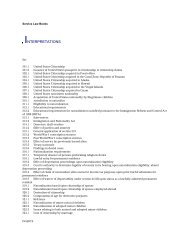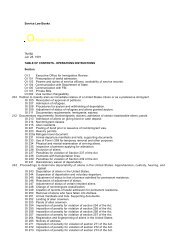You also want an ePaper? Increase the reach of your titles
YUMPU automatically turns print PDFs into web optimized ePapers that Google loves.
<strong>Inspector's</strong> <strong>Field</strong> <strong>Manual</strong><br />
22.8 Progressive Clearance.<br />
Some flights have been approved to deplane some passengers and crew at one port-of-entry and the remainder at<br />
an onward port. In such instances, the agent will deliver two Forms I-92 to the first port of entry. If you are at<br />
the first port, record on the flight log and one copy of the I-92 only the number of passengers and crew cleared at<br />
your port. Indicate on the second I-92 the number of passengers and crew which remained on board. Stamp the<br />
second I-92 with your admission stamp and return it to the agent, to be turned in at the second port. At the<br />
onward port, the agent will deliver the I-92 stamped by the first port, indicating the number of passengers and<br />
crewmembers which should be inspected. Complete the inspection, I-92 and flight log, including only those<br />
persons inspected at your port. Occasionally, there may be domestic passengers who boarded at the first port,<br />
but who are not subject to inspection at the onward port. Such passengers should be airline employees,<br />
"deadheading" crewmembers or their families. Such persons are not to be included in the flight log or I-92. [See 8<br />
CFR 231.1(c) for authority and conditions of progressive clearance and Chapter 42.8 discussion of progressive<br />
clearance approval.]<br />
22.9 Emergency Procedures during Canadian Air Traffic Controller Strikes.<br />
(a) The following guidelines and emergency procedures will be placed in force at the direction of Headquarters<br />
in the event of an air controller work stoppage in Canada.<br />
(1) Passengers destined to the United States from Canada will be accorded inspection at preclearance<br />
locations in Canada and bused to the United States. They will be accompanied by an airline representative or<br />
guard together with a memo from the INS supervisor in Canada stating the number of passengers inspected and<br />
boarded on the bus. In this situation, no inspection will take place at the port-of-entry.<br />
(2) Passengers destined overseas from Canada will be transported on buses from the Canadian airport<br />
to an airport in the United States. On arrival at a land port-of-entry, the airline representative accompanying the<br />
passengers will provide a list containing the names of all persons on the bus to the INS or Customs officer. The<br />
bus then may be allowed to proceed to the United States airport of embarkation where the airline representative<br />
will provide the list (second copy) of the names of all persons aboard the bus. An INS or Customs officer will<br />
observe the boarding of the flight and make a head count for comparison with the listed names. In the<br />
alternative, when the airport is close to the port-of-entry, an INS or Customs officer may escort the bus to the<br />
airport and observe the boarding. No inspection will be accorded at the port-of-entry or the airport in this<br />
situation.<br />
(3) Passengers arriving at a United States airport on a Canada-bound flight will be accorded full<br />
inspection if destined to the United States and inspection is requested. All other passengers will not be<br />
inspected, but will be transported on buses and escorted to Canada by airline representatives. These flights will<br />
be met at the U.S. port of departure by an INS or Customs officer who will then proceed to Canada. In some<br />
jurisdictions, the passengers will be inspected by Canadian officials at the border and in others, at Canadian<br />
airports of destination. In either case, Canadian officials should furnish a list (second copy) of the names of<br />
persons inspected to his United States counterpart at the port or at the airport in Canada (preclearance post).<br />
(4) Passengers traveling from one point in Canada to another point in Canada via a flight entirely<br />
within the United States will be bused to U.S. airports through ports-of-entry. The airline representative<br />
accompanying the passengers will furnish the port-of-entry with a list of names of all passengers and the<br />
port-of-entry will make a head count and furnish this information to the U.S. airport of embarkation. An INS or<br />
Customs officer will observe the boarding of the flight and take a head count. The inspector will then furnish the<br />
head count and other flight information to the United States airport of debarkation. Each flight will be met at<br />
the U.S. airport of debarkation by an INS or Customs officer who again will observe the boarding of buses and<br />
make a head count. The buses will then proceed to Canada where airline representatives will furnish Canadian<br />
officials with a list of the names of all persons (second copy of the list provided the port-of-entry) transported.<br />
(b) All carriers transporting passengers to and from U.S. airports for flights that usually originate or terminate<br />
in Canada under the provisions of guidelines 2 through 4, must be signatory to a Form I-426 agreement.<br />
Carriers not signatory to a Form I-426 agreement should be given a reasonable opportunity to enter into an<br />
agreement with the Service. If no agreement is entered into, those carriers not signatory shall be precluded from




